1.树模型
决策树:从根节点开始一步步走到叶子节点(决策)
所有的数据最终都会落到叶子节点,既可以做分类也可以做回归
2.树的组成
根节点:第一个选择点
非叶子节点与分支:中间过程
叶子节点:最终的决策结果
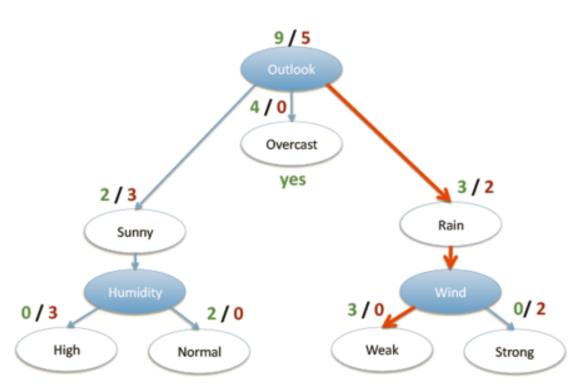
3.决策树的训练与测试
训练阶段:从给定的训练集构造出来一棵树(从跟节点开始选择特征, 如何进行特征切分)
测试阶段:根据构造出来的树模型从根节点一直走到叶子节点
如何切分特征(选择节点)
目标:通过一种衡量标准,来计算通过不同特征进行分支选择后的分类情况,找出来最好的那个当成根节点
衡量标准-熵
熵:熵是表示随机变量不确定性的度量 (解释:物体内部的混乱程度,比如杂货市场里面什么都有那肯定混乱呀,专卖店里面只卖一个牌子的那就稳定多啦)
公式:H(X)=- ∑ pi * logpi, i=1,2, ... , n
比如:
A集合[1,1,1,1,1,1,1,1,2,2] 、B集合[1,2,3,4,5,6,7,8,9,1]
显然A集合的熵值要低,因为A里面只有两种类别,相对稳定一些而B中类别太多了,熵值就会大很多
熵:不确定性越大,得到的熵值也就越大,当p=0或p=1时,H(p)=0,随机变量完全没有不确定性,当p=0.5时,H(p)=1,此时随机变量的不确定性最大

如何决策一个节点的选择呢?
信息增益:表示特征X使得类Y的不确定性减少的程度。(分类后的专一性,希望分类后的结果是同类在一起)
决策树构造实例
数据:14天打球情况
特征:4种环境变化
目标:构造决策树
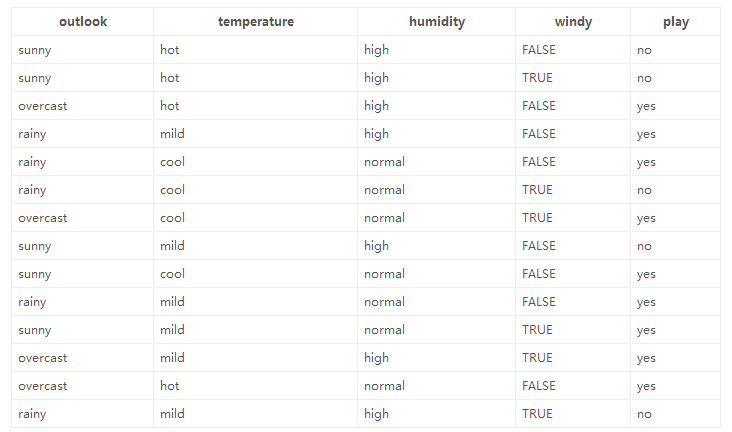
划分方式:4种
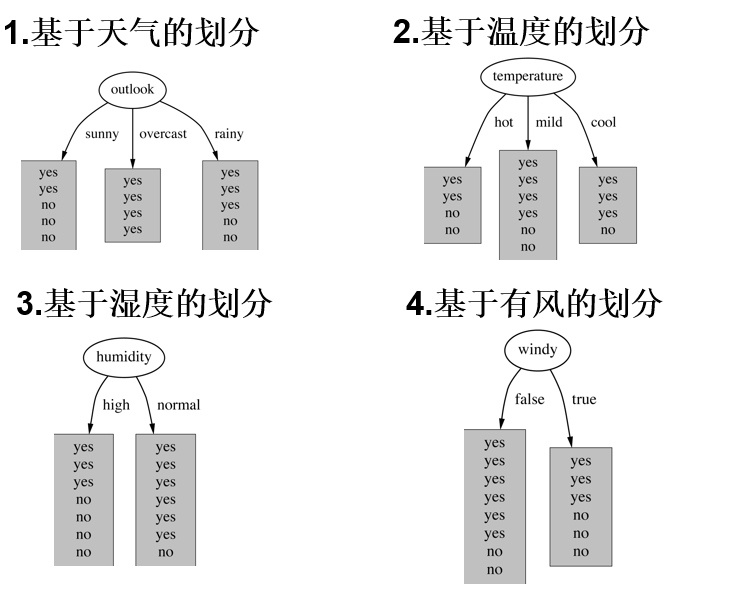
在历史数据中(14天)有9天打球,5天不打球,所以此时的熵应为:
4个特征逐一分析,先从outlook特征开始:
Outlook = sunny时,熵值为0.971
Outlook = overcast时,熵值为0
Outlook = rainy时,熵值为0.971
决策树算法
ID3:信息增益
问题:当数据存在一个ID特征,那么,决策树在id特征的熵为0,就会根据ID进行分支,但是ID特征毫无意义。决策树无法处理矩阵稀疏,种类比较多的id特征
(和熵的衡量标准类似,计算方式不相同)
连续值怎么办?
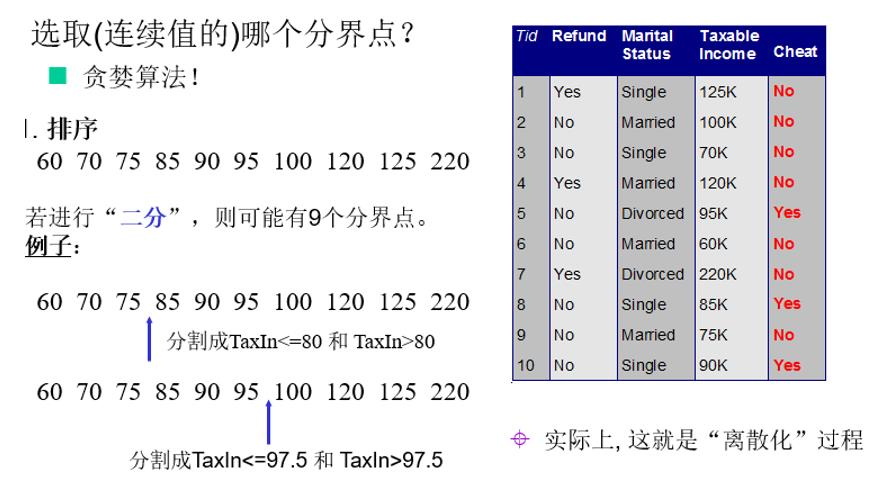
决策树剪枝策略
为什么要剪枝:决策树过拟合风险很大,理论上可以完全分得开数据
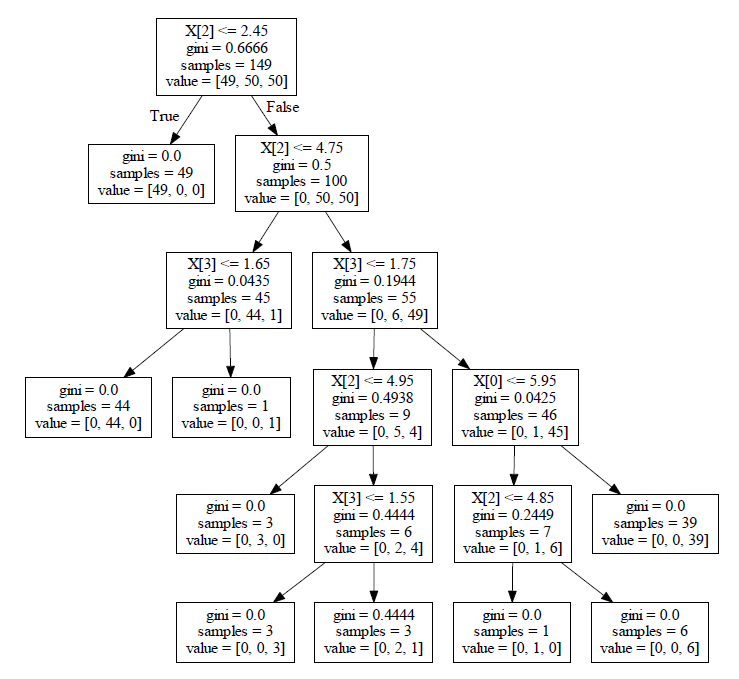
4.决策树代码实现
import matplotlib.pyplot as plt
from math import log
import operator
def createDataSet():
dataSet = [[0, 0, 0, 0, 'no'],
[0, 0, 0, 1, 'no'],
[0, 1, 0, 1, 'yes'],
[0, 1, 1, 0, 'yes'],
[0, 0, 0, 0, 'no'],
[1, 0, 0, 0, 'no'],
[1, 0, 0, 1, 'no'],
[1, 1, 1, 1, 'yes'],
[1, 0, 1, 2, 'yes'],
[1, 0, 1, 2, 'yes'],
[2, 0, 1, 2, 'yes'],
[2, 0, 1, 1, 'yes'],
[2, 1, 0, 1, 'yes'],
[2, 1, 0, 2, 'yes'],
[2, 0, 0, 0, 'no']]
labels = ['F1-AGE', 'F2-WORK', 'F3-HOME', 'F4-LOAN']
return dataSet, labels
def createTree(dataset, labels, featLabels):
classList = [example[-1] for example in dataset]
if classList.count(classList[0]) == len(classList):
return classList
if len(dataset[0]) == 1:
# 返回最多的类
return majorityCnt(classList)
# 选择最好的分裂节点
bestFeat = chooseBestFeatureToSplit(dataset)
# 最好的标签
bestLabels = labels[bestFeat]
featLabels.append(bestLabels)
myTree = {bestLabels: {}}
del labels[bestFeat]
featValue = [example[bestFeat] for example in dataset]
featUniqual = set(featValue)
for value in featUniqual:
sublabels = labels[:]
myTree[bestLabels][value] = createTree(splitDataSet(dataset, bestFeat, value), sublabels, featLabels)
return myTree
def majorityCnt(classList):
classCont = {}
for vot in classList:
if vot not in classCont.keys():
classCont[vot] = 0
classCont[vot] += 1
classCont = sorted(classCont, key=operator.itemgetter(1), reverse=True)
return classCont[0][0]
def chooseBestFeatureToSplit(dataset):
num_features = len(dataset[0]) - 1
baseEntropy = calcShannonEnt(dataset)
bestInfoGain = 0
bestFeature = -1
for i in range(num_features):
featList = [example[i] for example in dataset]
uniqueVals = set(featList)
newEntropy = 0
for val in uniqueVals:
subDataSet = splitDataSet(dataset, i, val)
prop = len(subDataSet) / len(dataset)
newEntropy += prop * calcShannonEnt(subDataSet)
infogain = baseEntropy - newEntropy
if infogain > bestInfoGain:
bestInfoGain = infogain
bestFeature = i
return bestFeature
def splitDataSet(dataset, axis, val):
retDataset = []
for feature in dataset:
if feature[axis] == val:
reducedFeatVec = feature[:axis]
reducedFeatVec.extend(feature[axis + 1:])
retDataset.append(reducedFeatVec)
return retDataset
def calcShannonEnt(dataset):
num_examples = len(dataset)
labelsCont = {}
for featVec in dataset:
if featVec[-1] not in labelsCont.keys():
labelsCont[featVec[-1]] = 0
labelsCont[featVec[-1]] += 1
ShannonEnt = 0
for key in labelsCont:
prop = labelsCont[key] / num_examples
ShannonEnt -= prop * log(prop, 2)
return ShannonEnt
def getNumLeafs(myTree):
numLeafs = 0
firstStr = next(iter(myTree))
secondDict = myTree[firstStr]
for key in secondDict.keys():
if type(secondDict[key]).__name__ == 'dict':
numLeafs += getNumLeafs(secondDict[key])
else:
numLeafs += 1
return numLeafs
def getTreeDepth(myTree):
maxDepth = 0
firstStr = next(iter(myTree))
secondDict = myTree[firstStr]
for key in secondDict.keys():
if type(secondDict[key]).__name__ == 'dict':
thisDepth = 1 + getTreeDepth(secondDict[key])
else:
thisDepth = 1
if thisDepth > maxDepth: maxDepth = thisDepth
return maxDepth
def plotNode(nodeTxt, centerPt, parentPt, nodeType):
arrow_args = dict(arrowstyle="<-")
createPlot.ax1.annotate(nodeTxt, xy=parentPt, xycoords='axes fraction',
xytext=centerPt, textcoords='axes fraction',
va="center", ha="center", bbox=nodeType, arrowprops=arrow_args)
def plotMidText(cntrPt, parentPt, txtString):
xMid = (parentPt[0] - cntrPt[0]) / 2.0 + cntrPt[0]
yMid = (parentPt[1] - cntrPt[1]) / 2.0 + cntrPt[1]
createPlot.ax1.text(xMid, yMid, txtString, va="center", ha="center", rotation=30)
def plotTree(myTree, parentPt, nodeTxt):
decisionNode = dict(boxstyle="sawtooth", fc="0.8")
leafNode = dict(boxstyle="round4", fc="0.8")
numLeafs = getNumLeafs(myTree)
depth = getTreeDepth(myTree)
firstStr = next(iter(myTree))
cntrPt = (plotTree.xOff + (1.0 + float(numLeafs)) / 2.0 / plotTree.totalW, plotTree.yOff)
plotMidText(cntrPt, parentPt, nodeTxt)
plotNode(firstStr, cntrPt, parentPt, decisionNode)
secondDict = myTree[firstStr]
plotTree.yOff = plotTree.yOff - 1.0 / plotTree.totalD
for key in secondDict.keys():
if type(secondDict[key]).__name__ == 'dict':
plotTree(secondDict[key], cntrPt, str(key))
else:
plotTree.xOff = plotTree.xOff + 1.0 / plotTree.totalW
plotNode(secondDict[key], (plotTree.xOff, plotTree.yOff), cntrPt, leafNode)
plotMidText((plotTree.xOff, plotTree.yOff), cntrPt, str(key))
plotTree.yOff = plotTree.yOff + 1.0 / plotTree.totalD
def createPlot(inTree):
fig = plt.figure(1, facecolor='white') # 创建fig
fig.clf() # 清空fig
axprops = dict(xticks=[], yticks=[])
createPlot.ax1 = plt.subplot(111, frameon=False, **axprops) # 去掉x、y轴
plotTree.totalW = float(getNumLeafs(inTree)) # 获取决策树叶结点数目
plotTree.totalD = float(getTreeDepth(inTree)) # 获取决策树层数
plotTree.xOff = -0.5 / plotTree.totalW;
plotTree.yOff = 1.0; # x偏移
plotTree(inTree, (0.5, 1.0), '') # 绘制决策树
plt.show()
if __name__ == '__main__':
dataset, labels = createDataSet()
featLabels = []
myTree = createTree(dataset, labels, featLabels)
createPlot(myTree)5.测试效果
























 1159
1159











 被折叠的 条评论
为什么被折叠?
被折叠的 条评论
为什么被折叠?










